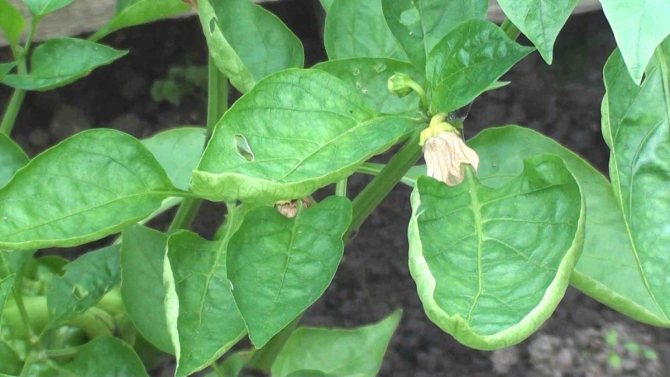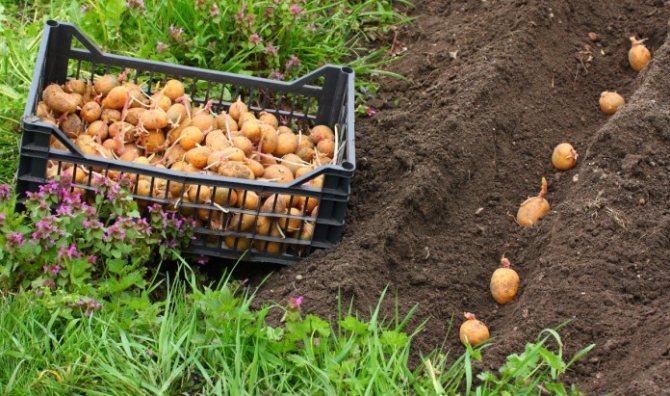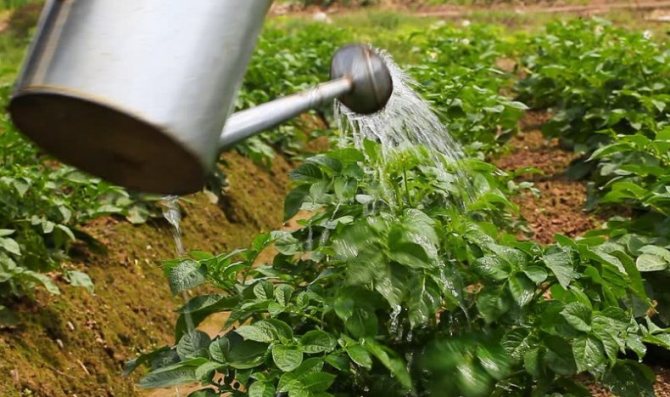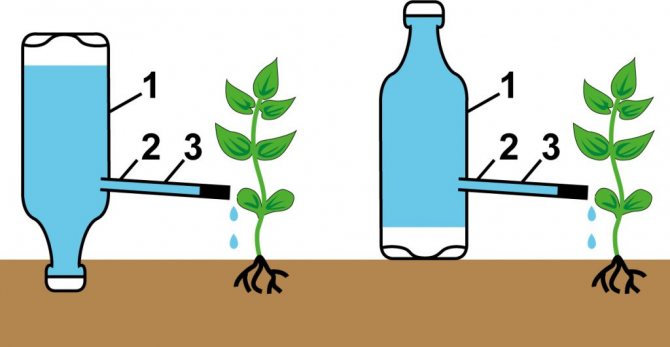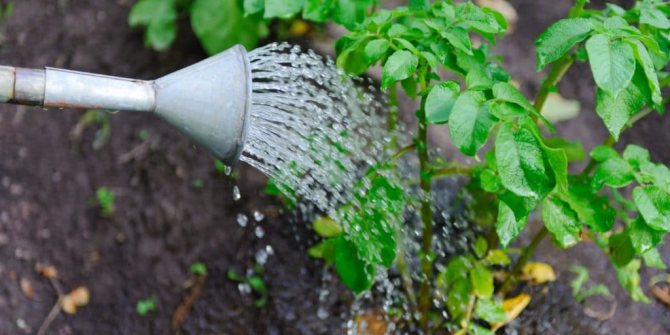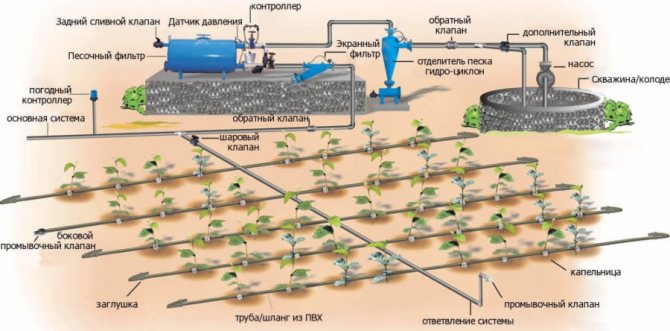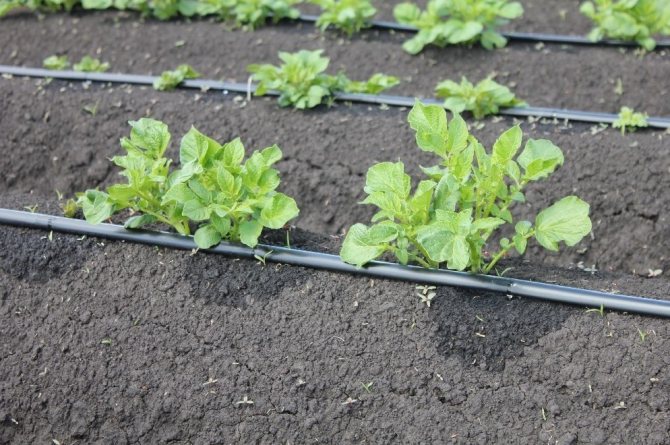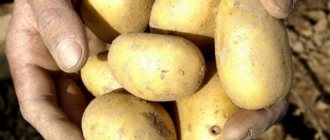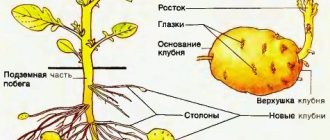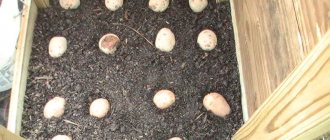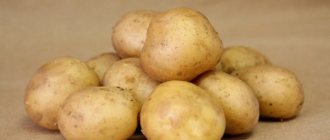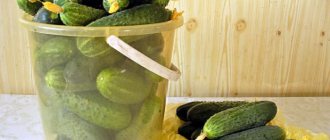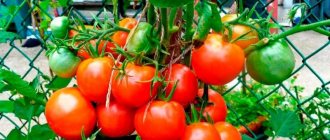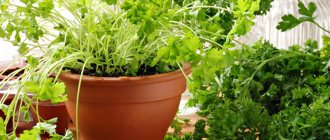Even in a normal, moderately rainy summer, potatoes need two or three waterings. During a drought, a good harvest cannot be obtained without additional moistening of the root system. Each bush requires at least 4 liters of water when watering. Bringing such an amount of water in buckets, even if the beds occupy only 1-2 acres, is hard labor.
It is much easier to water the garden with a hose. But in this case, too much water is wasted. In addition, if the plantings are watered from above, bacteria and fungi from the leaves of infected bushes enter the soil and infect healthy plants.
The best way out of the situation was found in the countries of the Middle East, where water is literally worth its weight in gold, and farmers nevertheless manage to collect rich crops, including potatoes. In such conditions, this would be impossible without the use of a drip irrigation system for potatoes.
Watering potatoes
It is very important for growing potatoes that the soil is moist, and this is especially important during dry and hot spring and summer days.
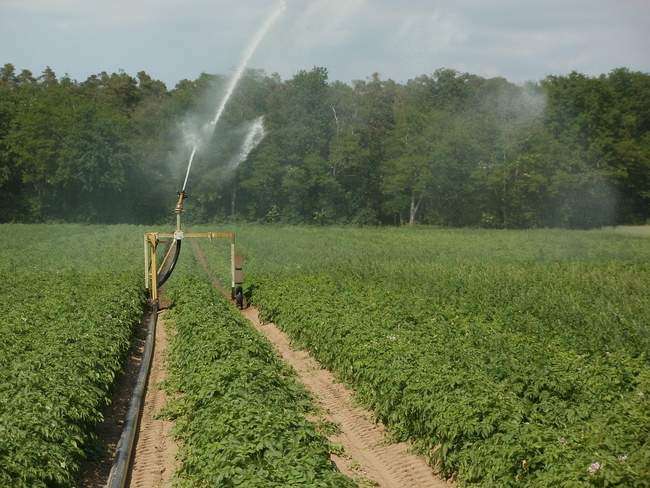
If there is regular rainfall, additional watering is not required. After all, waterlogging acts destructively and leads to rotting of tubers.
Watering must be carried out at several stages of potato growth:
- The first watering is necessary when the first shoots have already appeared. This usually happens after two weeks after planting (mid-May), the height of the shoots is from 5-10 cm. Then you should be guided by the circumstances of the weather conditions, especially on hot summer days, when it is immediately noticeable that the plants have wilted.
Pay attention to the lowest leaves of the plant. If they begin to dry out, watering is required.
Moreover, the more often you water, the less water you use in terms of volumes.
- The period of the appearance of the first buds, which is a clear sign of tuber formation. Usually this is the end of May, beginning of June.
- In the first decade of August, when tubers are actively gaining strength and mass in the ground.
When and how much to water
Watering must be carried out either in the early morning hours, when there is still no heat, or in the evening. If you water it during the day, the tops of the plants will simply "burn out".
If it is hot, the potatoes should be watered every four days, if the temperatures are moderate - once every 7-10 days.
Two days after watering, it is necessary to either loosen the soil or huddle the bush to prevent earthen crust and good aeration of the root system.
Potatoes of early varieties are especially demanding for watering, drying out of the soil under growing bushes is extremely undesirable. It is very simple to check the state of the potato bushes for the "desire to drink": run your hand into the ground near the bush so that all your fingers sink into the soil. If the hand is dry at the same time, watering is necessary.
The rate of water consumption per 1 bush is considered: 6-10 liters during the period of plant growth, 15-20 liters during the formation of tubers.


Correctly organized, non-spasmodic irrigation leads to an increase in yield by more than 20%. And in the case of irregular watering with rare strong waterlogging of the soil, it can lead to such changes as deformation of tubers and the formation of large cracks in them.
Basic watering techniques
- Sprinkling... The most commonly used method.It is necessary to monitor the fine-droplet stream and not to erode the roots. Unfortunately, this method most often leads to the development of fungal diseases of the potato.
- Furrow irrigation... The method compacts the upper layers of the soil, more loosening is required.
- Drip irrigation... The most optimal result, but requires effort and investment.
Dry irrigation method
If water saving is critical to you, then try dry irrigation to keep the soil moist. This is expressed in the mulching of the ground around the plantings.: green manure herbs, wet sawdust, under-warmed straw mass or peat. In addition to the fact that this shelter saves the plant from the external dry and hot air, it is also an excellent natural feeding during overheating.
Significance of water


Biochemical processes in a plant can only take place in the presence of water. Organic matter is formed from it and carbon dioxide. If the roots cannot draw water from the soil, the development of shoots, foliage and fruits is suspended. Water is a solvent for nutrients. It cools the roots when overheated and stimulates the activity of beneficial soil inhabitants.
Thanks to watering potatoes in the open field, you can achieve the following result:
- absorption of vitamins, minerals will be 30% more active;
- the tops will turn out to be more lush;
- resistance to disease will increase;
- 15% more stolons (tuber crops are formed on them);
- fruit weight will increase by 65%;
- grown tubers will have a beautiful presentation.
Weeding potatoes
There is a lot of controversy around whether potatoes need weeding. But we can definitely say that the root system of potatoes is much weaker than that of many weed plants. And in order for the tubers to grow large and healthy, the plant, and the roots, in particular, need aeration (achieved by loosening) and normal moisture.
Weeds grow especially on fertilized and fertilized soil. At the same time, they certainly take many useful ingredients from the soil, thereby depleting the nutrition of the tubers. Wheatgrass is especially terrible, because of it young nodules begin to rot in the ground.
Weeding potatoes will:
- Remove weeds that interfere with the normal growth of the potato crop.
- Loosen the soil, providing a quick supply of air and moisture to the growing tubers.
When to weed
This is usually done twice in an entire season:
- Twenty to thirty days after planting, when young plants will stretch 3-5 cm.
- When the bushes reach a height of 25-30 cm, but before the flowering of the bushes.
Usually weeding is combined with hilling.
Weeding tools
- Hand tools. Hoes, flat cutters, hoes.
If the plantings of potatoes are small, then there is little point in spending money on the purchase of motorized equipment. The most popular hand tool for weeding is the Fokin flat cutter (it requires less effort and you don't have to worry about cutting the root system of potatoes)
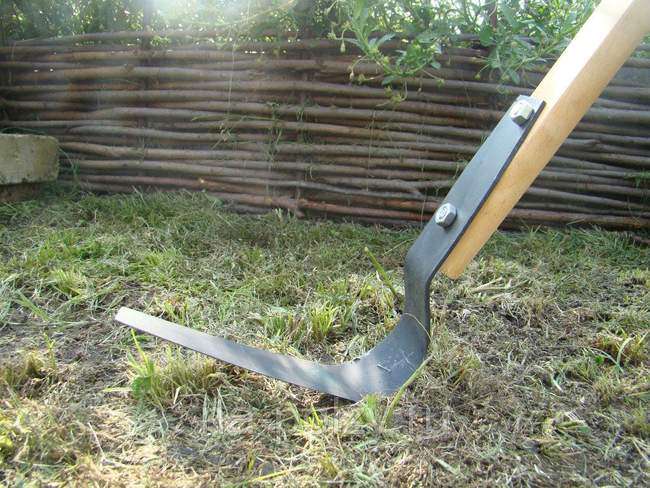

Also handy for hand weeding, a poker-like tool with joined ends


- Cultivators. Manual and powered (electric or gasoline). An essential tool for those gardeners who find physical effort difficult, for example, people with sore joints or aged.
The cultivator of the "Hedgehog" type is very popular, which perfectly copes with weeding and hilling the beds.
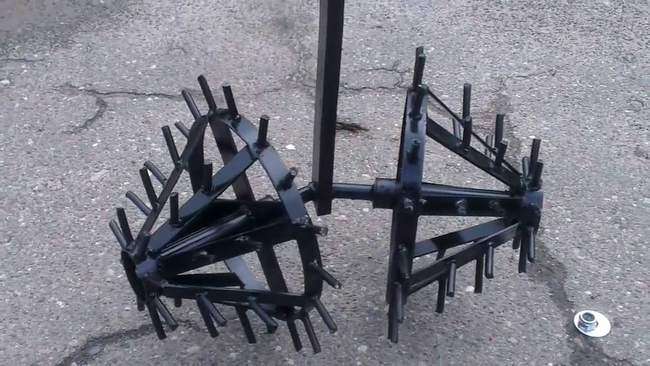

Potato weeding hedgehogs are a structure of two fastened cones, on each of which there are rings. Sharp spikes are attached to metal rings by welding. Two hedgehogs are put on the frame of the cultivator, and passages are made between the rows, during which weeds adhere remarkably and the earth is scooped up.
The hedgehog type attachments can be used in a cultivator with any control. But for heavy soils, a powerful engine is recommended.
With the right choice of weeding tool, labor costs are reduced, and the money spent on buying equipment will pay off with an excellent harvest.
- Motoblocks. This equipment is advisable to use in farms.
Drip irrigation technology for potatoes: how to implement our plans at their summer cottage


An example of calculating watering rates for potatoes.
Installing a drip irrigation system for potatoes on your own site will not be difficult, since the scheme of its device is quite simple. Let's consider it in more detail. To do this, you will need a barrel with a volume of 160 to 200 liters, a rigid plastic pipe with a diameter of 25 mm and a flexible hose with a diameter of 28 mm. It is necessary to install the barrel on a dais, making supports for it. Pre-equip the bottom of the barrel with a valve, and make a scale for the volume of water on the side surface. In the plastic pipe, make holes 2-3 mm in diameter, spaced from each other at a distance of about 20 cm. One of the ends of the pipe must be plugged with a stopper. Connect the valve and the plastic pipe with a flexible hose.
Drip irrigation of potatoes is carried out according to the following scheme: a plastic pipe must be placed in the aisle of potato bushes; through the valve in the barrel and the flexible hose, water will flow directly to the roots of the root crop through the holes drilled in the pipe. As soon as the watering of one row of potatoes is finished (while the required amount of liquid can be controlled on the scale made on the side surface of the barrel), you need to close the water and transfer the barrel to another row.
When installing such an irrigation system in your area, take into account that the holes in the pipe can become clogged, so they need to be cleaned from time to time.
The water pressure in such a potato irrigation system can be adjusted depending on the height of the barrel rise.
Hilling potatoes and why hilling improves yields
During the growth of potatoes, it is imperative to huddle, that is, pour the earth to the base of the bushes, raking it from the aisle, making it an elevation. The better the soil is loosened and the plants are huddled up, the tastier and more crumbly the tubers are.
Hilling is an important factor in increasing the yield (up to 25%). Hilling gives many advantages:
- Improvement of tuberization: bushes, supported by the ground, do not fall apart, they have stolons, from which tubers of the future harvest subsequently develop.
- Sun protection: the raised ground perfectly protects the tubers from the scorching rays.
- A properly hilled bush is better illuminated.
- Aeration and soil heating.
- The number of weeds is reduced.
- Protection against insect pests: it is more difficult for them to climb up the stem, on the ground that is elevated in the ridges. Thus, hilling helps to fight the Colorado potato beetle.


Hilling is usually carried out two to three times a season, always on moist soil, a day after watering or rains, preferably in the early morning hours or in the evening:
- The first time is when the seedlings reach a growth of 5-15 cm. Moreover, if there is a threat of frost, the seedlings should be almost completely covered with loosened soil, leaving only the tips of the upper leaves. On hot days, seedlings do not completely fall asleep - this impairs their growth.
- The second time is 20 days after the first, before flowering.
- The third time - if necessary, after the bushes reach a height of 25 cm. Moreover, the third hilling is done low, only in the area of the base of the bush.
Further, examining the bushes as they grow and develop, it is necessary to huddle only if necessary, noticing the bulging of the growing tubers.
Hilling methods
- Manual method using hoes
After the beginning of flowering, any care associated with hilling is inappropriate so as not to damage the active growth of tubers.
Hilling is most often done by shoveling the earth in a circle towards the base of the bush.With a strong growth of the bush, fan hilling is done - the stems move apart, while the earth is poured into the middle of the bush.
- Motorized way. The only disadvantage of this method is the cost of purchasing equipment.
- Method "Do it yourself" manual hiller. Significantly reduces labor costs when processing bushes, you just need to use your ingenuity and recycle the hoe.
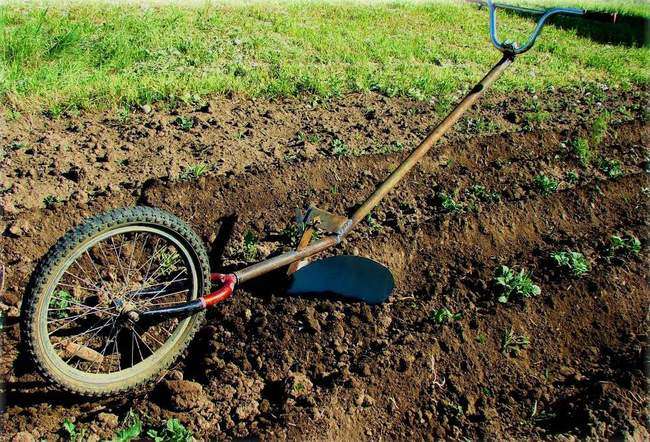

Consequences of improper moisture
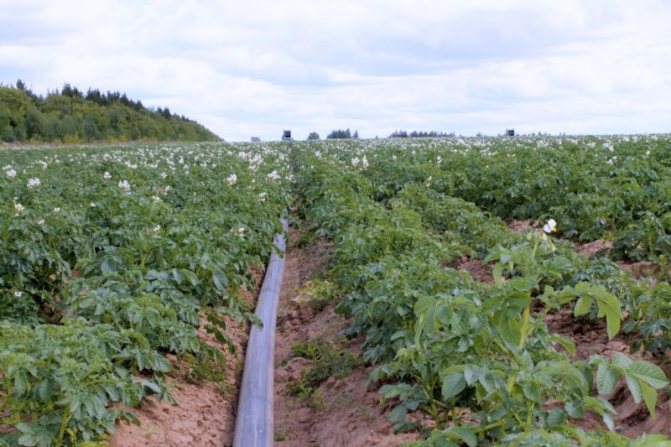

One of the main reasons for crop failure is lack of moisture. It can also lead to the fact that the tubers stop growing and become clumsy. In addition, water scarcity leads to the following:
- immunity falls;
- infectious diseases develop;
- the variety degenerates faster;
- the nutritional value of the fruit is reduced.
Attention!
If you often water late varieties of potatoes in the open field before budding, this will reduce resistance to heat and drought. Waterlogging before digging the crop leads to the fact that tubers lose their nutritional value and are worse stored.
In the absence of the ability to constantly moisten the soil, agronomists recommend using the following techniques:
- If the soil is sandy or clayey, humus must be added to it in an amount of 0.5 tons per hundred square meters. This will increase its water holding capacity.
- In the fall, thoroughly plow the soil to a depth of 30 cm, and in the spring, loosen it to a depth of 15 cm. This will help the high-quality formation of soil capillaries and their preservation. This option is suitable for light to moderately dense ground. The presence of heavy soil on the site requires spring plowing.
- At the end of summer, grow siderates (for example, mustard), and plow them in the fall. This will help keep off-season moisture.
- If possible, plant the crop earlier (immediately after the spring loosening of the site).
For arid regions, you need to choose drought-resistant crop varieties. Preferably early or late. They use moisture efficiently. It is better to refuse mid-season varieties. Tuber crops weighing more than 50 g are suitable for planting. They cannot be cut. It is better to plant the crop in the furrows, not in the ridges. In the fall, it is important to water the planting area. For each square meter, 70 liters of liquid should be consumed. So you can fill the soil with moisture for the next year. During periods of drought, foliar dressing should be carried out. For the first time, this should be done when the tops reach a height of 10 cm. The procedure is repeated for a flowering and faded plant.
Diseases and pests of potatoes
Insect pest control
There are a lot of insects that harm growing potatoes with their vital activity. The fight against them is also complicated by the desire to certainly grow an environmentally friendly crop, without chemicals. Therefore, in this article we will try to focus on the experience of gardeners - folk methods.
Experienced gardeners advise planting flower crops with a spicy aroma around the entire perimeter of the plantings: calendula and marigolds. We have described the beneficial properties of marigolds in this article.
- Wireworm. The larva of the click beetle is yellowish-brown in color. Making numerous moves in the tubers, they cause rot in them. Overdried soil is a favorable environment.
In the fight against the wireworm, it is important to prevent the earth from drying out, to collect the larvae for bait and burn.
Prevention of wireworm - plant siderates-legumes and siderates - mustard (before planting potatoes); put a handful of onion husks in each hole when planting.
- Colorado beetle. The biggest enemy of your potato planting. The danger is presented as adult beetles. and their larvae eating the tops.
Colorado potato beetle control - manual collection and destruction.
Prevention - scattering of ash around the bushes in the initial stage of the growing season; pouring ash into the holes during planting.
Chemical treatment against the Colorado potato beetle.Dilute preparations for the destruction of adults and larvae (for example, Confidor) twice as strong, but use, respectively, half the amount of the diluted preparation.


It is important to do the processing in mid-June, which will affect the safety of the future crop (2-3 months after processing). If you use the usual recommended dose and timing, then when processing in July, only a month and a half remains before harvest, and there will be more chemical residues in the tubers.
Disease protection
Various fungal, viral, bacterial diseases cause great damage to both plantings and the harvested crop during storage. Therefore, the most important moment in saving the crop is prevention and the fastest response to the manifestation of symptoms of the disease. The most important preventive measure is planting varieties that are resistant to identified diseases.
- Late blight is the most common disease, manifested in the appearance of brown spots on the bushes of the plant. The disease enters the tubers upon contact with diseased tops.
Treatment - treatment with copper sulfate and Bordeaux mixture of plantings at the very initial stage of the disease.
Prevention - mowing and destruction of tops before harvesting.
- Black leg (Rhizoctoniasis) is a disease that affects the entire plant as a whole. The tubers are covered with warts and damp.
Prevention - high-quality planting material, potash fertilizers (increased doses), adherence to the principles of crop rotation, mowing and destruction of tops before harvesting.
- Common scab is a disease that manifests itself in the appearance of ulcerative growths and formations on the tubers.
Prevention - planting varieties that are resistant to the disease.
Potato disease is fraught with the danger of partial and sometimes complete crop loss. Therefore, the correct definition of the disease, its prevention and treatment is an important stage in the cultivation of potatoes. You can find a more complete list of potato diseases and their treatment at the link.
Summarizing
Watering potatoes - an important stage in plant care. Choosing the right period to water the potatoes is a decision that directly affects the result of the gardener's work in the summer.
In addition, you need to know the specific water needs of plants in a certain period. Lack of moisture, as well as its excess, can cause the loss of a significant part of the crop.
Whether it is necessary to water the potatoes or not in a specific area, with the established weather, you can only determine on the spot, daily observing the beds with potatoes. The line between the required amount of water in potatoes and deviations is small, but you can notice it.
Follow the recommendations given in the article to protect the crop from loss.
Rate the article:
Potato System Magazine
Interregional information and analytical magazine for agribusiness professionals 12+
Social networks
Latest news
- An effective way to increase potato yields
- New varieties of potatoes for the production of fries. Less color, less acrylamide
- The German government will pay farmers a billion euros
- Potato cultivation area in Europe will grow
- Magnit has suspended imports of fruits and vegetables from China
Legal information
Restriction information
On observance of copyright
Important nuances
Knowing the following important nuances will help you get a stable harvest. smooth, healthy tubers every season:
- Uniform soil moisture. Potatoes do not like sudden changes in soil moisture. If you dry out the soil, and then water it abundantly, then the growth of potatoes will resume unevenly, and they will deform.
- Mulching potatoes. Covering the soil with a layer of mulch allows you to retain moisture in the soil for longer and, therefore, reduce the amount of watering.Mowed grass, green manure, straw are suitable as mulch. Over time, the mulch will rot and fertilize the soil.
- Early maturing crop varieties grow quickly and absorb moisture more intensively. Therefore, insufficient soil moisture significantly reduces the yield of early potatoes.
- Planting of zoned varieties. For planting, choose varieties that are adapted to the climatic conditions of your region.
- Early landing. In spring, plant potatoes as early as possible, at a soil temperature at a depth of 10 cm + 6 ... + 7 ° С. This will allow you to make the most of the spring moisture.
Leaving before flowering
Proper watering of potatoes provides for careful attention to the processes of its development. As soon as buds appear, nodules begin to form below. The plant at this time needs a lot of moisture. It has been found that the yield of potatoes is reduced by 30% if they lack water in this phase of the growing season.
Watering rates are increased if the first flowers are noticed. Without waiting for mass flowering, 12-15 liters of water should be poured under each bush after 3-4 days.


Requirements for the water regime of soils
Compliance with the water regime of the soil is a guarantee of obtaining a quality product. After all, interruptions in moisture first stop the development of the potato, and then start this process. Under these conditions, a significant portion of the uneven and ugly tubers will fall on the entire crop crop.
How often to water potato plantings depends primarily on the moisture content of the soil. It is important that not the surface is dry, but the lower layers of the soil.
You can find out if the ground is dry and whether it is necessary to water it in a simple way: by lowering your hand down to the base of your palm. With sufficient moisture, your fingertips will be slightly damp. If they are dry, then there is a need for water.
What should you choose?
The advantages of installing any of these systems can hardly be overestimated. Any of them will only benefit. Scientists have long found that with the use of drip irrigation systems, the yield of potatoes becomes much higher.
Every gardener, farmer or hobbyist chooses the drip irrigation system that will be more convenient on his site or that he can afford without a sensitive blow to finances. Remember that even if you install plastic bottles with straws, it will still be better than just watering with a hose! I personally use drip tape, but only when it hasn't rained for a long time. She fully meets my needs and I am satisfied with the results of her work.
The photos show the old-fashioned landing, not double rows. year 2014


How to grow more crops?
Any gardener and summer resident is pleased to receive a large harvest with large fruits. Unfortunately, it is far from always possible to get the desired result.
Plants often lack nutrition and minerals.
In such cases, our readers recommend using - the innovative bio-fertilizer BioGrow.
It has the following properties:
- Allows you to increase yields by 50% in just a few weeks of application.
- You can get a good harvest even on low-fertile soils and in unfavorable climatic conditions
- Absolutely safe
Read more about it here >>
ul


